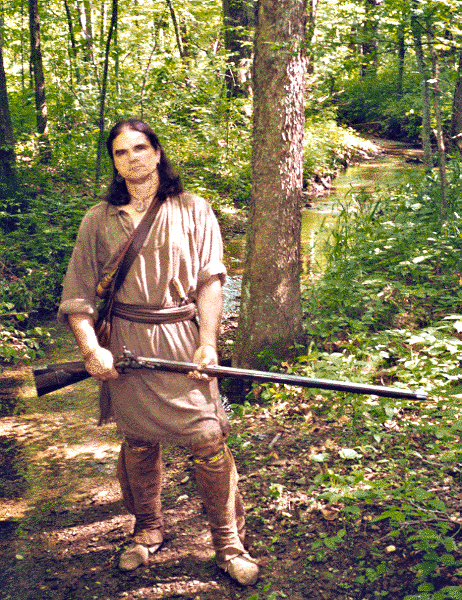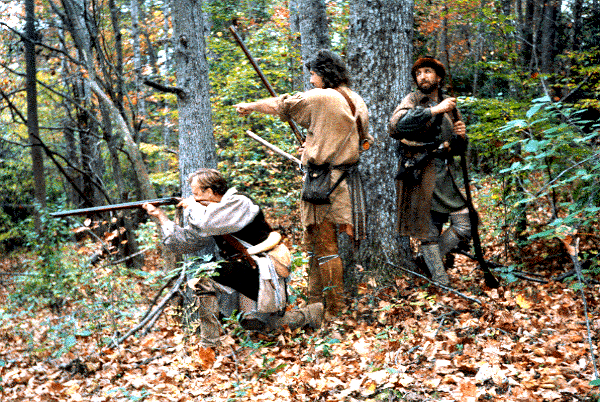|
Muzzle Blasts Online |
|
...for the muzzleloading enthusiast |
|
The muzzleblasts.com domain, subdomains, content, etc., are neither affiliated with the NMLRA nor its paper magazine Muzzle Blasts |
|
Muzzle Blasts Online |
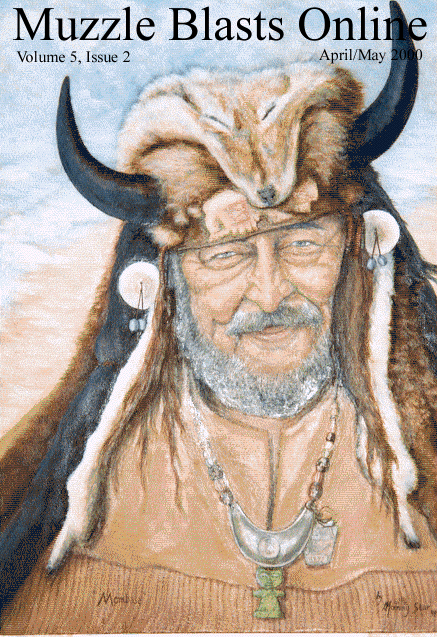
|
|
|
|
|
|
Jesse Hughes: The Legend, the Man
John Curry
Remember the old saying "Sometimes even a blind squirrel finds a nut"? Well, thanks to Dale Payne (my long-time trail partner from Fayetteville, West Virginia) I've stumbled into a pistachio farm! I had mentioned to Dale while we were encamped on the Big South Fork of the Cumberland that I was looking for information on an original longhunter named Jesse Hughes. Jesse was an early Virginia/Kentucky frontiersman, a great hunter, and a famous Indian fighter. Top-notch historian that he is, Squire Payne was kind enough to mail me a haversack full of fascinating accounts and descriptions regarding this venerable woodsman.
Hughes' lifestyle and his intense preoccupation with hunting and the unexplored wild places make him an excellent example for those of us who attempt to emulate the longhunter. Like other famous longhunters such as Elisha Walden, Henry Skaggs, and Thomas Sharpe Spencer, Jesse never farmed, but hunted exclusively for a living. Due to his extremely violent disposition toward all Indians, many historians look upon Jesse Hughes as the role model for the well known borderman Lewis Wetzel.
Fortunately, we have a wealth of information on the exploits, mind-set, and personal appearance of Jesse. One of the best and most specific descriptions of any Virginia/Carolina frontiersman I have ever seen comes from Lucullus V. McWhorter's The Border Settlers of Northwestern Virginia. The following quotes from pages 33 to 35 give us an excellent, intimate look at an actual 18th century wilderness explorer, longhunter, and Indian fighter:
"With (Samuel) Pringle's band of prospectors of 1769, came a youth of about nineteen - Jesse Hughes. He was of Welsh extraction, slight in his proportions, and light and active in his movements. He possessed a form as erect as that of an Indian, and had endurance and fleetness of limb that no man of his day surpassed. His height was about five feet and nine inches, and his weight never exceeded one hundred and forty-five pounds. He had thin lips, a narrow chin, a nose that was sharp and inclined to the Roman form, little or no beard, light hair, and eyes of that indefinable color that one person would pronounce grey, another blue, but which was both - and neither. They were piercing, cold, fierce, and as penetrating and restless as those of the mountain panther. He was of an irritable, vindictive, and suspicious nature, and his hatred, when aroused, knew no bounds. Yet it is said that he was true to those who gained his friendship.
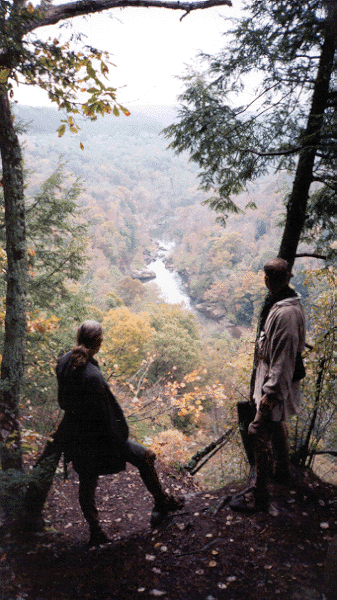
|
|
Henry Behr and Gordon Smith stand high above a rocky outcropping overlooking the Red River in the
Daniel Boone National Forest of Kentucky. |
In an interview with an intelligent and reputable lady, who, in her childhood, had known Jesse Hughes, and had been intimately acquainted with some of his family, I was given this vivid description of the characteristics and personal appearance of the great Indian fighter:
'Hughes' countenance was hard, stern and unfeeling; his eyes were the most cruel and vicious I ever saw. He was profane and desperately wicked. He was very superstitious. His temper was fierce and uncontrollable. He never worked, but spent his time in hunting and scouting. His clothing was colored in the ooze made from the bark of the chestnut oak; he would wear no other color, this shade harmonizing with the forest hues and rendering him less conspicuous to game and Indians. When scouting, his dress consisted only of the long hunting shirt, belted at the waist, open leggings, moccasins, and a brimless cap; or a handkerchief bound about his head. Thus dressed, he was ever ready for the chase, or the trail of the Indian foe.'
His mode of dress as described above has been amply verified from other sources. When Indian incursions were expected, Jesse Hughes wore his hunting shirt both day and night, without regard to weather.
Of the pioneers who came with Pringle into the Buckhannon country, Withers says:
'The others of the party (William Hacker, Thomas and Jesse Hughes, John and William Radcliff and John Brown) appear to have employed their time exclusively in hunting, neither of them making any improvement of land for his own benefit. Yet they were of considerable service to the new settlement. Those who had commenced clearing land were supplied by them with an abundance of meat, while in their hunting excursions through the country, a better knowledge of it was obtained than could have been acquired, had they been engaged in making improvements.' "
Hughes was definitely a fine hunter and evidently enjoyed forays into the unknown and unexplored western forests. McWhorter further states; "Tradition on the Big Sandy River says that in previous times, Jesse Hughes scouted and hunted all over eastern Kentucky; that he was an associate of Matthias Harman, and that he was one of the famous 'Long Hunters'. On one occasion he swam Red River, holding his rifle and shot pouch high and dry in one hand. This was a tributary of the Kentucky River in eastern Kentucky. Red River is spoken of by the 'Long Hunters' who first came upon it in 1769." (The Border Settlers of Northwestern Virginia, p.212.)
In 1771 Jesse was married to Miss Grace Tanner. He built their cabin on Hacker's Creek, near the site of an old Shawnee village at the mouth of a stream that has ever since been known as "Jesse's Run". Hardesty in his History of Gilmer County informs us of another landmark scout in which Hughes participated shortly thereafter:
"Jesse Hughes and his brother Elias Hughes, along with William Lowther made the first exploration of the Little Kanawha River... It was in the autumn of the year 1772 that these three daring adventurers, whose names are all illustrious in the annals of pioneer history, left the spot where Clarksburg now stands and traveled up the west fork of the Monongahela river. From there they crossed the dividing ridge, and journeyed down Sand Creek to its junction with the Little Kanawha River.
Here was a beautiful mountain river, upon whose rapid current the eye of civilized man had never before rested, and amid the surrounding hills the sound of his voice had never before been heard. But they must follow its tortuous course - its windings like a silver thread - to its junction with some other mighty river, they knew not what. So the journey was continued down the river and as they proceeded they bestowed the names upon its tributaries, which they have ever since borne...
...at the mouth of another stream were bluff banks filled with slate, and Slate Creek was left behind. But the mouth of the river down which they were journeying was now near at hand and soon the mighty La Belle Riviere of the early French voyagers was in sight, and our explorers stood upon its banks - probably the first Englishmen that ever stood upon the spot where the city of Parkersburg now stands."
These lengthy hunts and scouts into the unexplored, uninhabited regions of Northwestern Virginia and the "Dark & Bloody Ground" of Kentucky would tend to explain the confusing total absence of any information concerning Hughes during certain years (particularly in the early to mid-1770s), in contrast to numerous accounts of his exploits occurring both before and after those years. Apparently Jesse wasn't one to stick around the settlements for very long.
Jesse Hughes was, no doubt, one of the most successful Indian fighters who ever lived. The famous nineteenth-century historian Reuben Gold Thwaites observed, "Hughes was a noted border scout, but a man of fierce, unbridled passions, and so confirmed an Indian hater that no tribesman, however peaceful his record, was safe in his presence." (Chronicles of Border Warfare, p.137.)
Anything even approaching a thorough account of Hughes' activities against the natives would be far beyond the scope of this article. Nevertheless, I would like to pass along a few interesting, documented encounters...
"At a time of great danger from the incursions of the Indians, when the citizens of the neighborhood were in a fort at Clarksburg, Hughes one morning observed a lad very intently fixing his gun. 'Jim', said he, 'what are you doing that for?' 'I am going to shoot a turkey that I hear gobbling on the hillside,' said Jim. 'I hear no turkey,' said the other. 'Listen,' said Jim: 'there, didn't you hear it? Listen again.' 'Well,' says Hughes, after hearing it repeated, 'I'll go and kill it.' 'No you won't' said the boy, ' it is my turkey; I heard it first.' 'Well,' said Hughes, 'but you know I am the best shot. I'll go and kill it, and give you the turkey.' The lad demurred but at length agreed. Hughes went out of the fort on the side that was farthest from the supposed turkey, and passing along the river, went up a ravine and cautiously creeping through the bushes behind the spot, came in whence the cries issued, and, as he expected, espied a large Indian sitting on a chestnut stump, surrounded by sprouts, gobbling, and watching if any one would come from the fort to kill the turkey. Hughes shot him before the Indian knew of his approach, took off the scalp, and went into the fort, where Jim was waiting for his prize. 'There now,' says Jim, 'you have let the turkey go. I would have killed it if I had gone.' 'No' says Hughes, 'I didn't let it go,' and, taking out the scalp, threw it down. 'There take your turkey, Jim, I don't want it.' The lad was overcome, and nearly fainted to think of the certain death he had escaped, purely by the keen perception and good management of Jesse Hughes.' " (History of the Early Settlement and Indian Wars of Western Virginia; pp. 410, 411, Dr. Willis DeHass.)
The following event took place during an Indian attack on West's Fort in June of 1778:
"The screams of the women alarmed the men in the fort; and seizing their guns, they ran out, just as Mrs. Freeman fell. Several guns were fired at the Indian while he was getting her scalp, but with no effect. They served however, to warn the men who went out, that danger was at hand; and they quickly came in.
Jesse Hughes and John Schoolcraft (who were out) in making their way to the fort, came very near two Indians standing by the fence looking towards the men at West's, so intently, that they did not perceive any one near them. They however, were observed by Hughes and Schoolcraft, who, avoiding them, made their way in, safely, Hughes immediately took up his gun, and learning the fate of Mrs. Freeman, went with some others to bring in the corpse. While there, he proposed to go and shew them, how near he had approached the Indians after the alarm had been given, before he saw them. Charles and Alexander West, Chas. Hughes, James Brown, and John Steeth, went with him. Before they had arrived at the place, one of the Indians was heard to howl like a wolf; and the men with Hughes moved on in the direction from which the sound proceeded. Supposing that they were then near the spot, Jesse Hughes howled in like manner, and being instantly answered, they ran to a point of the hill and looking over it, saw two Indians coming towards them. Hughes fired and one of them fell. The other took to flight." (Chronicles of Border Warfare; p.246, Alexander Scott Withers.)
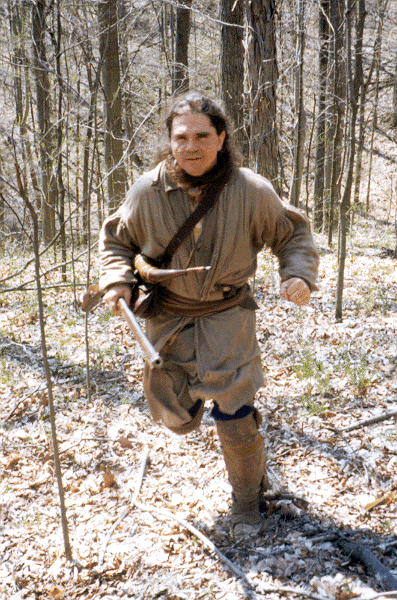
|
|
"Leaving the fort at night, he broke by their sentinels and ran with speed to the Buchannon fort." |
Remember in the great 1939 Darryl F. Zanuck movie Drums Along The Mohawk, where Henry Fonda had to run from his besieged fort to another settlement and get help to save the fort from an Indian attack? Here's the real-life version:
"The frequent incursions of the Indians into this settlement, in the year 1778, had caused the inhabitants to desert their homes the next year, and shelter themselves in places of greater security; but being unwilling to give up the improvements which they had already made and commence anew in the woods, some few families returned to it during the winter, & on the approach of spring moved into the fort. They had not been long here, before the savages made their appearance, and continued to invest the fort for some time. Too weak to sally out and give them battle, and not knowing when to expect relief, the inhabitants were almost reduced to despair, when Jesse Hughes resolved at his own hazard, to try to obtain assistance to drive off the enemy. Leaving the fort at night, he broke by their sentinels and ran with speed to the Buchannon fort. Here he prevailed on a party of the men to accompany him to West's, and relieve those who had been so long confined there." (Chronicles of Border Warfare; p.288, Alexander Scott Withers.)
In regard to Jesse's skill, Willis Degas observes: "He was a great favorite, and no scouting party could be complete, unless Jesse Hughes had something to do with it." (History of the Early Settlement and Indian Wars of Western Virginia, p.412.)
Early in March of 1781 a party of Indians invaded the upper Monongahela river, inflicting much killing and bloodshed. Word was quickly passed and spies were sent out to watch for the enemy. Thwaites goes on to say:
"By some of these, the savages were discovered on the West Fork, near the mouth of Isaac's Creek, and intelligence of it immediately carried to the forts. A company of men, going in pursuit, came in view of their encampment, awhile before night, on a branch of Hughes' river, ever since known as Indian Creek. Jesse and Elias Hughes - active, intrepid and vigilant men - were left to watch the movements of the savages, while the remainder retired a small distance to refresh themselves, and prepare to attack them in the morning.
Before day Col. Lowther arranged his men in order of attack, and when it became light, on the preconcerted signal being given, a general fire was poured in. Five of the savages fell dead and the others fled leaving at their fires, all their shot bags and plunder, and all their guns, except one." (Chronicles of Border Warfare, pp. 311, 312)
One of the last accounts we have of Jesse Hughes' remarkable abilities and talent is contained, once again, in McWhorter's The Border Settlers of Northwestern Virginia (pp. 206 and 207). This heart- pounding incident took place in 1793, and reads like a fight scene from The Last of the Mohicans:
"The following fall, the Indians killed and devoured a cow that belonged to Jesse Hughes. They carried away with them the bell that the cow wore. One afternoon they rattled this bell on the mountainside above the fort. Some said to Jesse that his cow was coming home. He knew, however that she had been killed, and he replied that he would 'make the bell ring for something the next morning'. That night he hid himself on the mountain where he had heard the bell ringing that afternoon. As soon as it was light enough to see to shoot he heard the bell once again, and he cautiously made his way in the direction of the sound. Having gone but a short distance, he discovered two Indians, one large, one smaller in size. The big Indian was standing with his gun raised, ready for instant use, and the smaller one was going about on his hands and knees, with the bell on his neck, rattling it like a cow would if grazing in the woods. Hughes shot the big Indian and the small one ran. Jesse dropped his gun, grabbed the one belonging to the dead Indian and pursuing the other Indian, soon came up with him and shot him. The gun Hughes had taken from the fallen Indian was discovered as belonging to Benjamin Carpenter (killed by the same two Indians that spring) and it along with the powder horn and shot pouch were returned to the Carpenters."
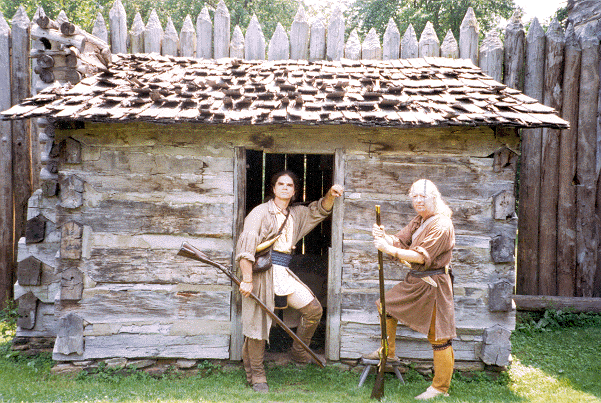
|
|
The author and John Evans passing the time of day inside Prickett's Fort near Fairmont, West Virginia.
Jesse Hughes was a welcome and familiar face here. |
Jesse left his place on Hacker's Creek in the fall of 1797. His eye fixed once again on the unsettled frontier, McWhorter says: "With his family, livestock, and his personal belongings he moved overland to that area around Vincennes, in the present State of Indiana." (The Border Settlers of Northwestern Virginia; p.211). Several years later he moved into eastern Kentucky and finally came back to West Virginia, where he died in the fall of 1829.
Jesse Hughes was a wonderful hunter, a great scout, a significant wilderness explorer, and a legendary Indian fighter. More importantly for us, he was also a common man -dressing, equipping and conducting himself in a manner appropriate to his time period, familiar and recognizable to the common people of the Virginia border lands. It is through the fascinating study of documented historic figures such as Jesse Hughes that we are able to become more realistic frontiersmen on our own scouts and forays into the wild, lonely places...
Bibliography
de Hass, Dr. Willis. History of the Early Settlement and Indian Wars of Western Virginia.
Hardesty. The History of Gilmer County.
McWhorter, Lucullus V. The Border Settlers of Northwestern Virginia.
Withers, Alexander Scott. Chronicles of Border Warfare.
